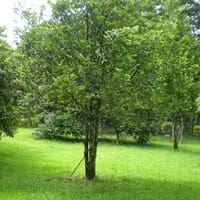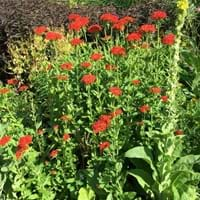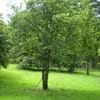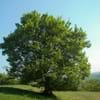Life Span
Perennial
Perennial
Origin
Central Asia, Eastern Europe, Europe, Nepal, Southern Asia, Southern Europe
Eastern Europe, Kazakhstan, Mongolia, Northwestern China, Russia
Types
Not Available
not available
Number of Varieties
Not Available
Habitat
Cold Regions, Hills, Hillside
Banks
USDA Hardiness Zone
9-11
3-8
Sunset Zone
1a, 1b, 2a, 2b, 3a, 3b, 4, 5, 6, 7, 8, 9, 14, 15, 16, 17, 18, 19, 20, 21
A1, A2, A3, 1a, 1b, 2a, 2b, 3a, 3b, 4, 5, 6, 7, 8, 9, 10, 14, 15, 16, 17, 18, 19, 20, 21, 22, 23, 24
Habit
Oval or Rounded
Upright/Erect
Flower Color
Not Available
Red, Orange, Rose, Salmon, Peach, Orange Red
Flower Color Modifier
Bicolor
Bicolor
Fruit Color
Green, Brown
Brown
Leaf Color in Spring
Green, Copper
Green
Leaf Color in Summer
Dark Green
Green
Leaf Color in Fall
Green
Green
Leaf Color in Winter
Green
Light Green
Leaf Shape
Oval
Ovate elongated
Plant Season
All year
Spring, Summer
Sunlight
Full Sun
Full Sun, Partial Sun, Partial shade
Type of Soil
Clay, Loam, Sand
Clay, Loam, Sand
The pH of Soil
Acidic, Neutral
Acidic, Neutral, Alkaline
Soil Drainage
Well drained
Average
Bloom Time
Late Spring, Early Summer
Late Spring, Early Summer, Summer
Tolerances
Not Available
Drought
Where to Plant?
Ground
Ground
How to Plant?
Budding, Seedlings
Divison, Seedlings
Plant Maintenance
Medium
Medium
Watering Requirements
Requires watering in the growing season, Water Deeply, Water when top layer of soil becomes dry
Do not let dry out between waterings
In Summer
Lots of watering
Lots of watering
In Spring
Moderate
Moderate
In Winter
Average Water
Average Water
Soil pH
Acidic, Neutral
Acidic, Neutral, Alkaline
Soil Type
Clay, Loam, Sand
Clay, Loam, Sand
Soil Drainage Capacity
Well drained
Average
Sun Exposure
Partial Sun, Partial shade
Full Sun, Partial Sun, Partial shade
Pruning
In Early Autumn, Prune to stimulate growth, Remove dead leaves
In late autumn, Remove deadheads
Fertilizers
fertilize in spring, Nitrogen
All-Purpose Liquid Fertilizer
Pests and Diseases
Anthracnose, Armillaria mellea, Blight, Caterpillars, Crown gall, Crown rot, fungus, Powdery mildew, Red blotch
Aphids, Red blotch, Slugs
Plant Tolerance
Drought, Frost
Drought
Flower Petal Number
Single
Single
Fragrant Bark/Stem
Yes
No
Foliage Texture
Medium
Medium
Foliage Sheen
Glossy
Glossy
Invasive
Sometimes
Sometimes
Attracts
Aphids, Bees, Beetles, Caterpillar, Small mammals
Butterflies, Hummingbirds
Allergy
Abdominal distension, flushing of face, hallucinations, Headache, Pollen
Not Available
Aesthetic Uses
Not Used For Aesthetic Purpose
Showy Purposes
Beauty Benefits
Good for skin and hair
No Beauty Benefits
Environmental Uses
Absorbs greenhouse gases, Absorbs huge amounts of CO2, Air purification, Amazing growth rate, Erosion control, Food for birds, Food for insects, Forms dense stands, Nesting sites for birds, Prevent Soil Erosion, Shadow Tree, Shelter for wildlife, Windbreak
Air purification
Medicinal Uses
Anemia, anti-cancer, Antispasmodic, Asthma, Diarrhea, Healing, Stomach spasms, Thoat infection
Not Available
Part of Plant Used
Fruits, Seeds
Whole plant
Other Uses
Making deodorants, Oil is used for aromatherapy, Oil is used in mosquito repellents, Used as a laxative, Used for its medicinal properties, Used for making soaps, Used in biomass
Used as Ornamental plant
Used As Indoor Plant
No
No
Used As Outdoor Plant
Yes
Yes
Garden Design
Container, Groundcover
Bedding Plant, Feature Plant, Mixed Border
Botanical Name
Myristica fragrans
LYCHNIS chalcedonica
Common Name
Nutmeg
Maltese cross, Jerusalem cross, Burning love, Dusky salmon
In Hindi
जायफल
Maltese cross
In German
Muskatnuss
Malteserkreuz
In French
noix de muscade
Maltese cross
In Spanish
nuez moscada
cruz de Malta
In Greek
μοσχοκάρυδο
σταυρό της Μάλτας
In Portuguese
noz-moscada
cruz de Malta
In Polish
gałka muszkatołowa
krzyż maltański
In Latin
nutmeg
Duces crucis
Phylum
Magnoliophyta
Magnoliophyta
Class
Magnoliopsida
Magnoliopsida
Order
Magnoliales
Caryophyllales
Family
Poaceae
Caryophyllaceae
Clade
Angiosperms, Monocots
Angiosperms, Core eudicots, Eudicots
Tribe
Myrteae
Not Available
Subfamily
Myrtoideae
Not Available
Number of Species
Not Available
Season and Care of Nutmeg and Maltese Cross Flower
Season and care of Nutmeg and Maltese Cross Flower is important to know. While considering everything about Nutmeg and Maltese Cross Flower Care, growing season is an essential factor. Nutmeg season is All year and Maltese Cross Flower season is All year. The type of soil for Nutmeg is Clay, Loam, Sand and for Maltese Cross Flower is Clay, Loam, Sand while the PH of soil for Nutmeg is Acidic, Neutral and for Maltese Cross Flower is Acidic, Neutral, Alkaline.
Nutmeg and Maltese Cross Flower Physical Information
Nutmeg and Maltese Cross Flower physical information is very important for comparison. Nutmeg height is 1,000.00 cm and width 1,220.00 cm whereas Maltese Cross Flower height is 60.00 cm and width 25.40 cm. The color specification of Nutmeg and Maltese Cross Flower are as follows:
Nutmeg flower color: Not Available
Nutmeg leaf color: Green and Copper
Maltese Cross Flower flower color: Red, Orange, Rose, Salmon, Peach and Orange Red
- Maltese Cross Flower leaf color: Green
Care of Nutmeg and Maltese Cross Flower
Care of Nutmeg and Maltese Cross Flower include pruning, fertilizers, watering etc. Nutmeg pruning is done In Early Autumn, Prune to stimulate growth and Remove dead leaves and Maltese Cross Flower pruning is done In late autumn and Remove deadheads. In summer Nutmeg needs Lots of watering and in winter, it needs Average Water. Whereas, in summer Maltese Cross Flower needs Lots of watering and in winter, it needs Average Water.





